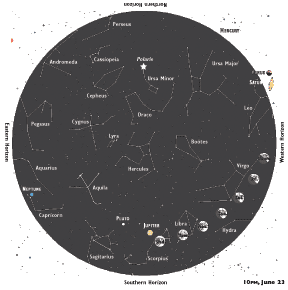|
|
 |
||||||||||
|
|||||||||||
|
|||||||||||
Good Morning, SunshineLong days and short nights in the summer solstice’s wake
Thursday the 21st at 2:06pm marks summer solstice. On this first day of summer, the sun peaks at its farthest point north of the equator, 231⁄2 degrees, appearing to stand still above the Tropic of Cancer. In Greek, solstice means sun stands still. Greek philosopher Hipparchus in the second century bc noted that on the day of summer solstice, the sun was within the constellation Cancer. Today, more than 2,000 years later, the sun at solstice travels between Gemini and Taurus. The Tropic of Cancer marks the northern edge of the tropics. For the rest of us in the northern hemisphere, the sun appears at its highest point in the sky on summer solstice, about five degrees south of the celestial zenith. Solstice also marks our longest day and shortest night of the year, while it is the opposite for those in the southern hemisphere. Although the longest day of the year, summer solstice marks neither the earliest sunrise nor the latest sunset. Because earth is not a true sphere but more egg-shaped — and because its orbit around the sun is not a true circle but more elliptical — our earliest sunrise was June 14th and our latest sunset won’t be until the 28th. Still, we’ll have almost 15 hours of sunlight, with the solstice sun rising at 5:42:57am and sunset at 8:36:47pm. With so much sunlight — as well as this week’s waxing gibbous moon — it’s a good thing that summer’s night skies are so rich with bright objects. Venus and Saturn are nearing next week’s conjunction low in the west at sunset. Jupiter arcs across the ecliptic in the south through evening and into the early morning, while Mars rises a few hours past midnight. Illustration: © Copyright 1925 M.C. Escher/Cordon Art-Baarn-Holland; Graphics: © Copyright 2007 Pacific Publishers. Reprinted by permission from the Tidelog graphic almanac. Bound copies of the annual Tidelog for Chesapeake Bay are $14.95 ppd. from Pacific Publishers, Box 480, Bolinas, CA 94924. Phone 415-868-2909. Weather affects tides. This information is believed to be reliable but no guarantee of accuracy is made by Bay Weekly or Pacific Publishers. The actual layout of Tidelog differs from that used in Bay Weekly. Tidelog graphics are repositioned to reflect Bay Weekly’s distribution cycle.Tides are based on National Oceanic and Atmospheric Administration and are positioned to coincide with high and low tides of Tidelog. |
|||||||||||
|
|||||||||||
|
|
|||||||||||
|
© COPYRIGHT 2007 by New Bay Enterprises, Inc. All rights reserved. |
|||||||||||


